Quality Use of Medicines (QUM) and Mr. T's Case Study Analysis
VerifiedAdded on 2021/02/21
|9
|2357
|76
Essay
AI Summary
This academic essay delves into the Quality Use of Medicines (QUM) framework within the context of the Australian National Medicines Policy, using the case of an 84-year-old widower, Mr. T, to illustrate key issues. The essay identifies alcoholism and self-medication as critical factors influencing Mr. T's health, given his multiple medical conditions including heart failure, hypertension, and arthritis. It examines the risks associated with alcohol consumption, particularly its interaction with his prescribed medications, and the dangers of unregulated self-medication practices. The essay provides recommendations for addressing these issues, advocating for health education and medication reviews to improve Mr. T's medication adherence and overall health outcomes. The conclusion emphasizes the importance of collaborative efforts among healthcare professionals, pharmacists, and communities to ensure the safe and effective use of medicines and minimize adverse drug reactions.
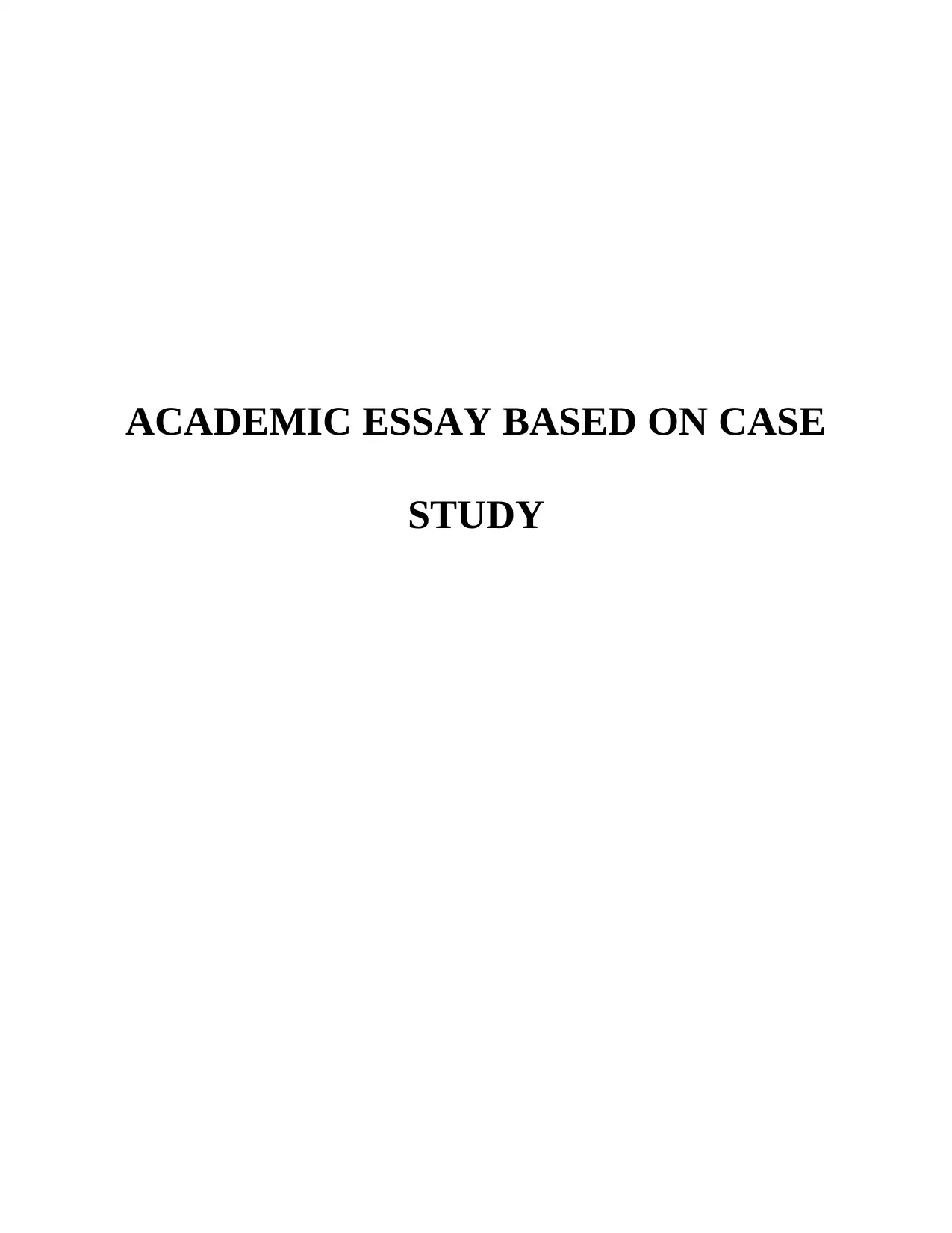
ACADEMIC ESSAY BASED ON CASE
STUDY
STUDY
Paraphrase This Document
Need a fresh take? Get an instant paraphrase of this document with our AI Paraphraser
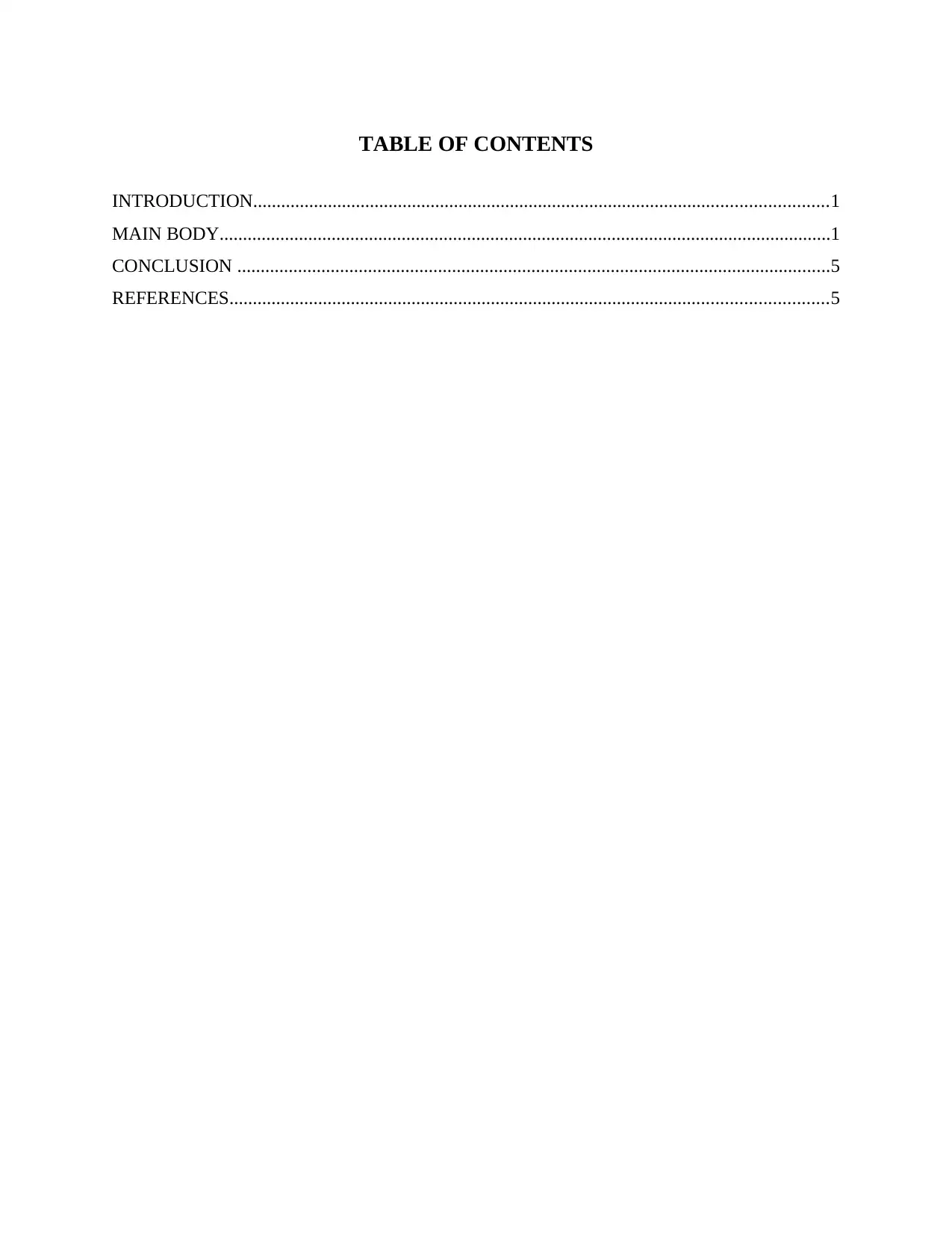
TABLE OF CONTENTS
INTRODUCTION...........................................................................................................................1
MAIN BODY...................................................................................................................................1
CONCLUSION ...............................................................................................................................5
REFERENCES................................................................................................................................5
INTRODUCTION...........................................................................................................................1
MAIN BODY...................................................................................................................................1
CONCLUSION ...............................................................................................................................5
REFERENCES................................................................................................................................5
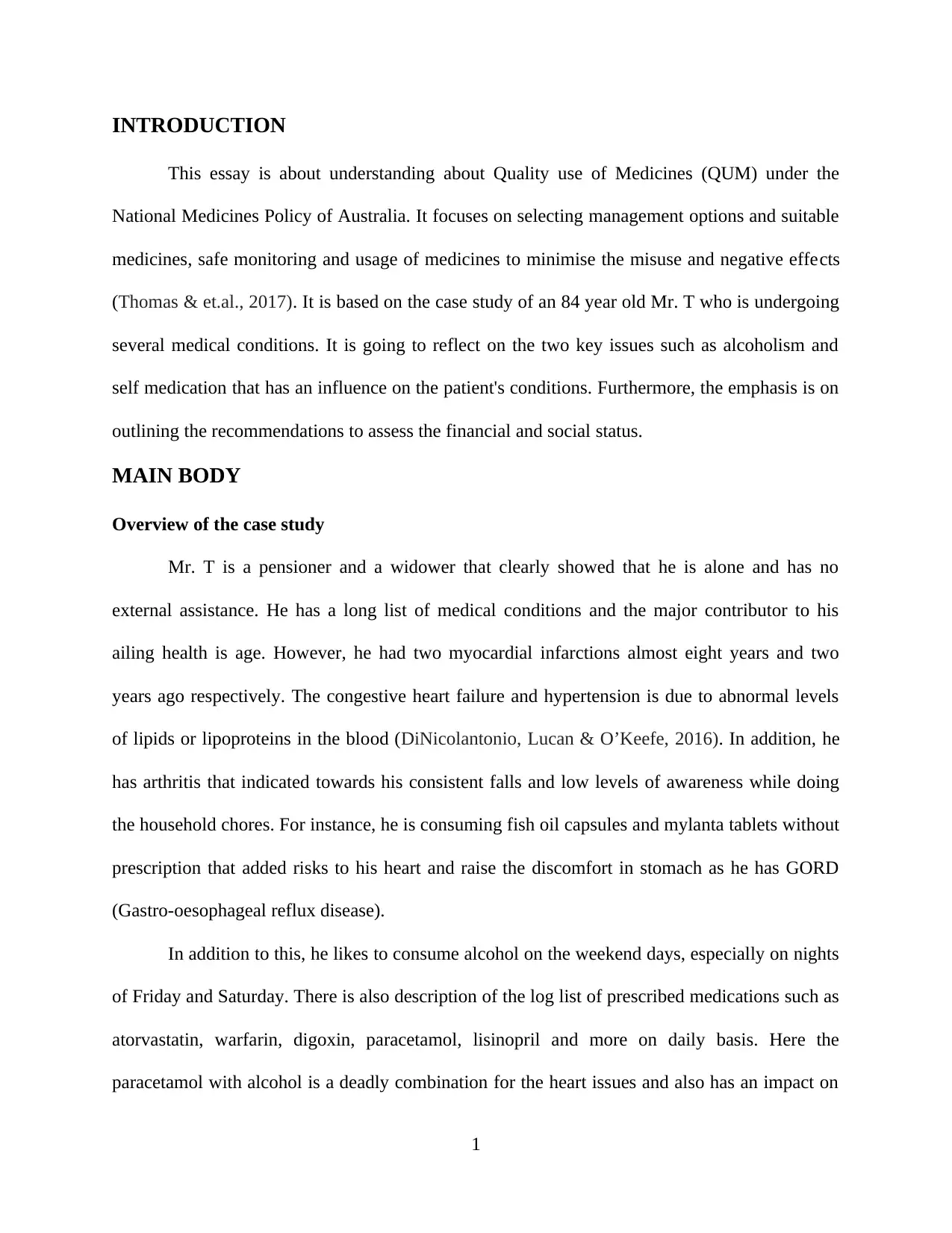
INTRODUCTION
This essay is about understanding about Quality use of Medicines (QUM) under the
National Medicines Policy of Australia. It focuses on selecting management options and suitable
medicines, safe monitoring and usage of medicines to minimise the misuse and negative effects
(Thomas & et.al., 2017). It is based on the case study of an 84 year old Mr. T who is undergoing
several medical conditions. It is going to reflect on the two key issues such as alcoholism and
self medication that has an influence on the patient's conditions. Furthermore, the emphasis is on
outlining the recommendations to assess the financial and social status.
MAIN BODY
Overview of the case study
Mr. T is a pensioner and a widower that clearly showed that he is alone and has no
external assistance. He has a long list of medical conditions and the major contributor to his
ailing health is age. However, he had two myocardial infarctions almost eight years and two
years ago respectively. The congestive heart failure and hypertension is due to abnormal levels
of lipids or lipoproteins in the blood (DiNicolantonio, Lucan & O’Keefe, 2016). In addition, he
has arthritis that indicated towards his consistent falls and low levels of awareness while doing
the household chores. For instance, he is consuming fish oil capsules and mylanta tablets without
prescription that added risks to his heart and raise the discomfort in stomach as he has GORD
(Gastro-oesophageal reflux disease).
In addition to this, he likes to consume alcohol on the weekend days, especially on nights
of Friday and Saturday. There is also description of the log list of prescribed medications such as
atorvastatin, warfarin, digoxin, paracetamol, lisinopril and more on daily basis. Here the
paracetamol with alcohol is a deadly combination for the heart issues and also has an impact on
1
This essay is about understanding about Quality use of Medicines (QUM) under the
National Medicines Policy of Australia. It focuses on selecting management options and suitable
medicines, safe monitoring and usage of medicines to minimise the misuse and negative effects
(Thomas & et.al., 2017). It is based on the case study of an 84 year old Mr. T who is undergoing
several medical conditions. It is going to reflect on the two key issues such as alcoholism and
self medication that has an influence on the patient's conditions. Furthermore, the emphasis is on
outlining the recommendations to assess the financial and social status.
MAIN BODY
Overview of the case study
Mr. T is a pensioner and a widower that clearly showed that he is alone and has no
external assistance. He has a long list of medical conditions and the major contributor to his
ailing health is age. However, he had two myocardial infarctions almost eight years and two
years ago respectively. The congestive heart failure and hypertension is due to abnormal levels
of lipids or lipoproteins in the blood (DiNicolantonio, Lucan & O’Keefe, 2016). In addition, he
has arthritis that indicated towards his consistent falls and low levels of awareness while doing
the household chores. For instance, he is consuming fish oil capsules and mylanta tablets without
prescription that added risks to his heart and raise the discomfort in stomach as he has GORD
(Gastro-oesophageal reflux disease).
In addition to this, he likes to consume alcohol on the weekend days, especially on nights
of Friday and Saturday. There is also description of the log list of prescribed medications such as
atorvastatin, warfarin, digoxin, paracetamol, lisinopril and more on daily basis. Here the
paracetamol with alcohol is a deadly combination for the heart issues and also has an impact on
1
⊘ This is a preview!⊘
Do you want full access?
Subscribe today to unlock all pages.

Trusted by 1+ million students worldwide
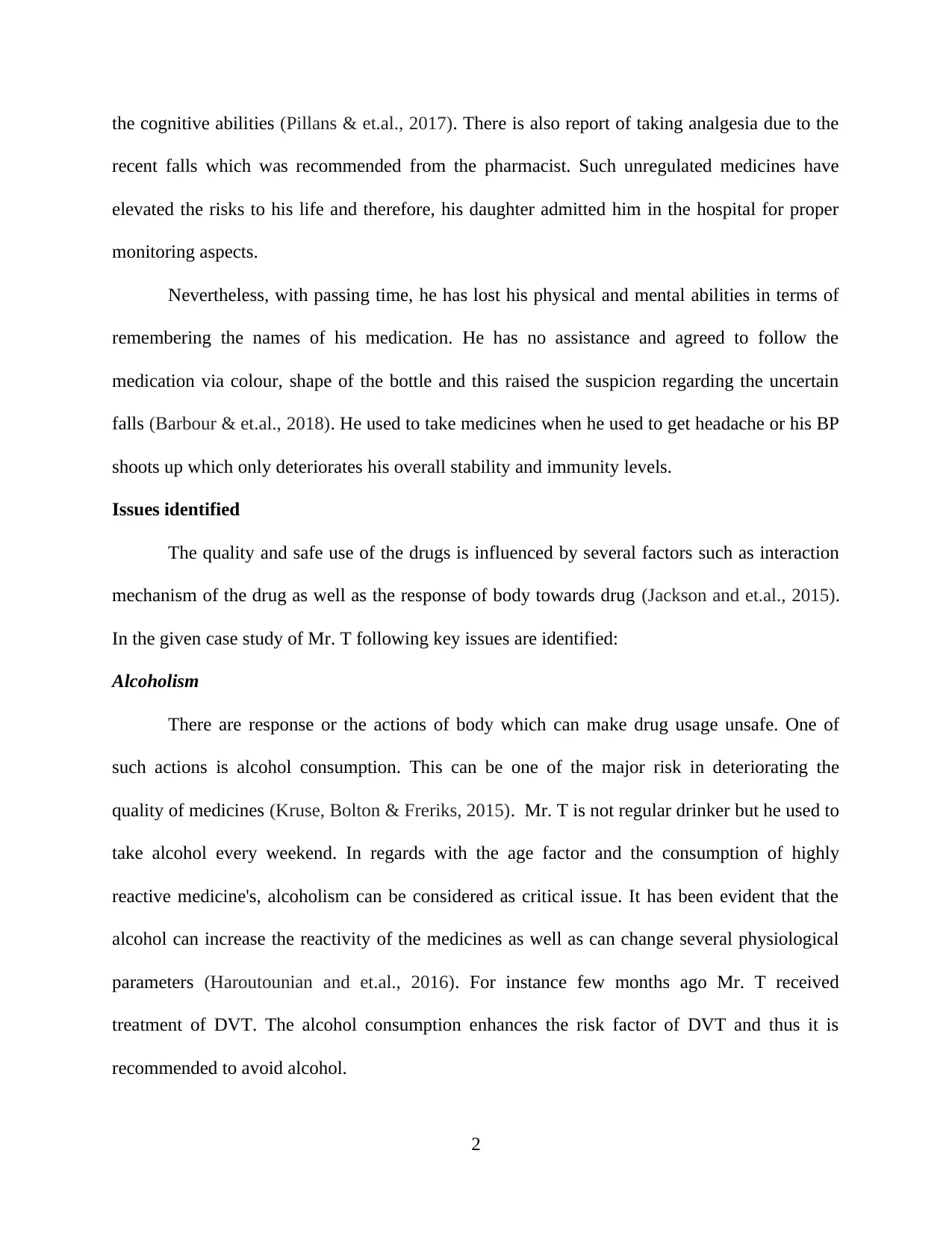
the cognitive abilities (Pillans & et.al., 2017). There is also report of taking analgesia due to the
recent falls which was recommended from the pharmacist. Such unregulated medicines have
elevated the risks to his life and therefore, his daughter admitted him in the hospital for proper
monitoring aspects.
Nevertheless, with passing time, he has lost his physical and mental abilities in terms of
remembering the names of his medication. He has no assistance and agreed to follow the
medication via colour, shape of the bottle and this raised the suspicion regarding the uncertain
falls (Barbour & et.al., 2018). He used to take medicines when he used to get headache or his BP
shoots up which only deteriorates his overall stability and immunity levels.
Issues identified
The quality and safe use of the drugs is influenced by several factors such as interaction
mechanism of the drug as well as the response of body towards drug (Jackson and et.al., 2015).
In the given case study of Mr. T following key issues are identified:
Alcoholism
There are response or the actions of body which can make drug usage unsafe. One of
such actions is alcohol consumption. This can be one of the major risk in deteriorating the
quality of medicines (Kruse, Bolton & Freriks, 2015). Mr. T is not regular drinker but he used to
take alcohol every weekend. In regards with the age factor and the consumption of highly
reactive medicine's, alcoholism can be considered as critical issue. It has been evident that the
alcohol can increase the reactivity of the medicines as well as can change several physiological
parameters (Haroutounian and et.al., 2016). For instance few months ago Mr. T received
treatment of DVT. The alcohol consumption enhances the risk factor of DVT and thus it is
recommended to avoid alcohol.
2
recent falls which was recommended from the pharmacist. Such unregulated medicines have
elevated the risks to his life and therefore, his daughter admitted him in the hospital for proper
monitoring aspects.
Nevertheless, with passing time, he has lost his physical and mental abilities in terms of
remembering the names of his medication. He has no assistance and agreed to follow the
medication via colour, shape of the bottle and this raised the suspicion regarding the uncertain
falls (Barbour & et.al., 2018). He used to take medicines when he used to get headache or his BP
shoots up which only deteriorates his overall stability and immunity levels.
Issues identified
The quality and safe use of the drugs is influenced by several factors such as interaction
mechanism of the drug as well as the response of body towards drug (Jackson and et.al., 2015).
In the given case study of Mr. T following key issues are identified:
Alcoholism
There are response or the actions of body which can make drug usage unsafe. One of
such actions is alcohol consumption. This can be one of the major risk in deteriorating the
quality of medicines (Kruse, Bolton & Freriks, 2015). Mr. T is not regular drinker but he used to
take alcohol every weekend. In regards with the age factor and the consumption of highly
reactive medicine's, alcoholism can be considered as critical issue. It has been evident that the
alcohol can increase the reactivity of the medicines as well as can change several physiological
parameters (Haroutounian and et.al., 2016). For instance few months ago Mr. T received
treatment of DVT. The alcohol consumption enhances the risk factor of DVT and thus it is
recommended to avoid alcohol.
2
Paraphrase This Document
Need a fresh take? Get an instant paraphrase of this document with our AI Paraphraser
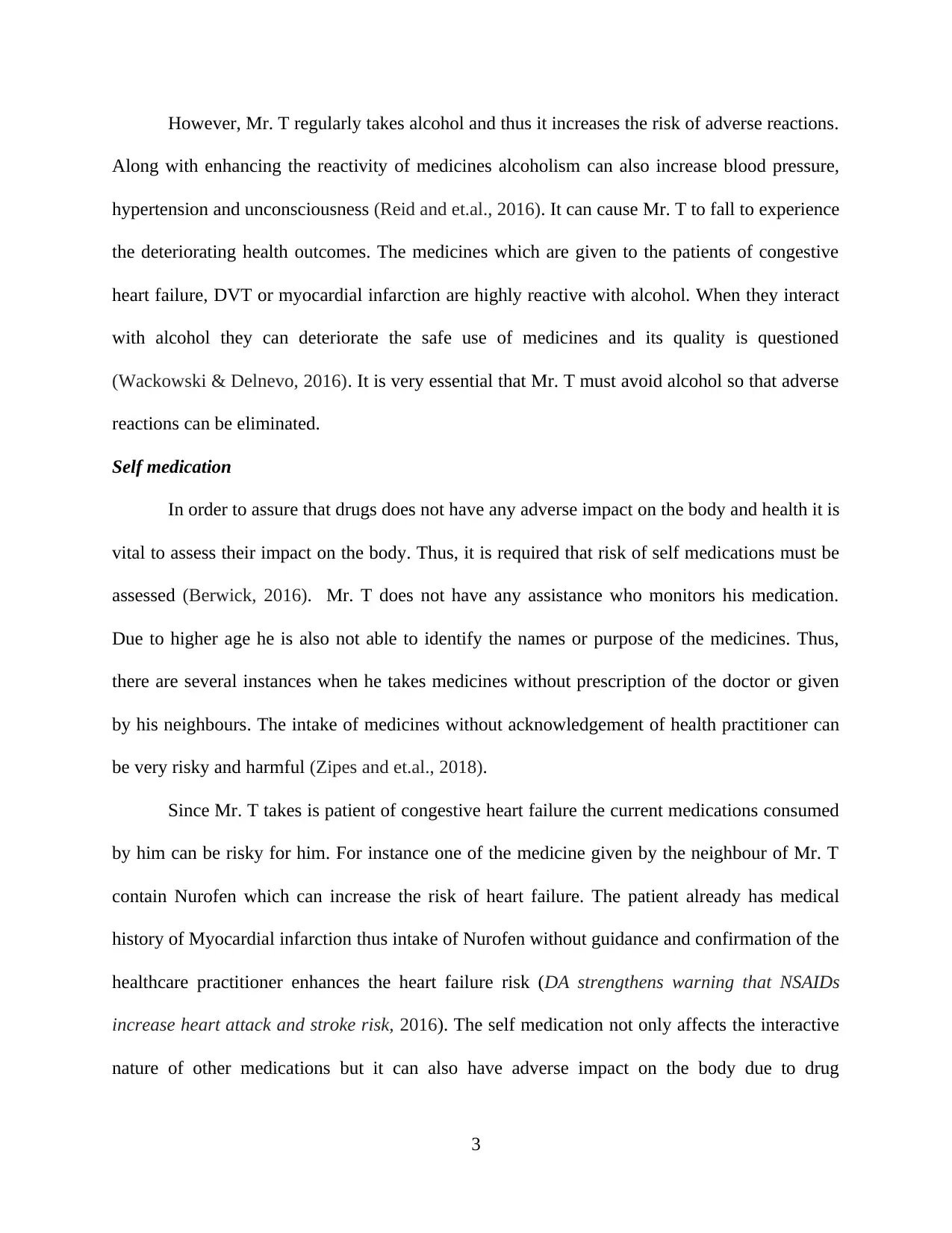
However, Mr. T regularly takes alcohol and thus it increases the risk of adverse reactions.
Along with enhancing the reactivity of medicines alcoholism can also increase blood pressure,
hypertension and unconsciousness (Reid and et.al., 2016). It can cause Mr. T to fall to experience
the deteriorating health outcomes. The medicines which are given to the patients of congestive
heart failure, DVT or myocardial infarction are highly reactive with alcohol. When they interact
with alcohol they can deteriorate the safe use of medicines and its quality is questioned
(Wackowski & Delnevo, 2016). It is very essential that Mr. T must avoid alcohol so that adverse
reactions can be eliminated.
Self medication
In order to assure that drugs does not have any adverse impact on the body and health it is
vital to assess their impact on the body. Thus, it is required that risk of self medications must be
assessed (Berwick, 2016). Mr. T does not have any assistance who monitors his medication.
Due to higher age he is also not able to identify the names or purpose of the medicines. Thus,
there are several instances when he takes medicines without prescription of the doctor or given
by his neighbours. The intake of medicines without acknowledgement of health practitioner can
be very risky and harmful (Zipes and et.al., 2018).
Since Mr. T takes is patient of congestive heart failure the current medications consumed
by him can be risky for him. For instance one of the medicine given by the neighbour of Mr. T
contain Nurofen which can increase the risk of heart failure. The patient already has medical
history of Myocardial infarction thus intake of Nurofen without guidance and confirmation of the
healthcare practitioner enhances the heart failure risk (DA strengthens warning that NSAIDs
increase heart attack and stroke risk, 2016). The self medication not only affects the interactive
nature of other medications but it can also have adverse impact on the body due to drug
3
Along with enhancing the reactivity of medicines alcoholism can also increase blood pressure,
hypertension and unconsciousness (Reid and et.al., 2016). It can cause Mr. T to fall to experience
the deteriorating health outcomes. The medicines which are given to the patients of congestive
heart failure, DVT or myocardial infarction are highly reactive with alcohol. When they interact
with alcohol they can deteriorate the safe use of medicines and its quality is questioned
(Wackowski & Delnevo, 2016). It is very essential that Mr. T must avoid alcohol so that adverse
reactions can be eliminated.
Self medication
In order to assure that drugs does not have any adverse impact on the body and health it is
vital to assess their impact on the body. Thus, it is required that risk of self medications must be
assessed (Berwick, 2016). Mr. T does not have any assistance who monitors his medication.
Due to higher age he is also not able to identify the names or purpose of the medicines. Thus,
there are several instances when he takes medicines without prescription of the doctor or given
by his neighbours. The intake of medicines without acknowledgement of health practitioner can
be very risky and harmful (Zipes and et.al., 2018).
Since Mr. T takes is patient of congestive heart failure the current medications consumed
by him can be risky for him. For instance one of the medicine given by the neighbour of Mr. T
contain Nurofen which can increase the risk of heart failure. The patient already has medical
history of Myocardial infarction thus intake of Nurofen without guidance and confirmation of the
healthcare practitioner enhances the heart failure risk (DA strengthens warning that NSAIDs
increase heart attack and stroke risk, 2016). The self medication not only affects the interactive
nature of other medications but it can also have adverse impact on the body due to drug
3
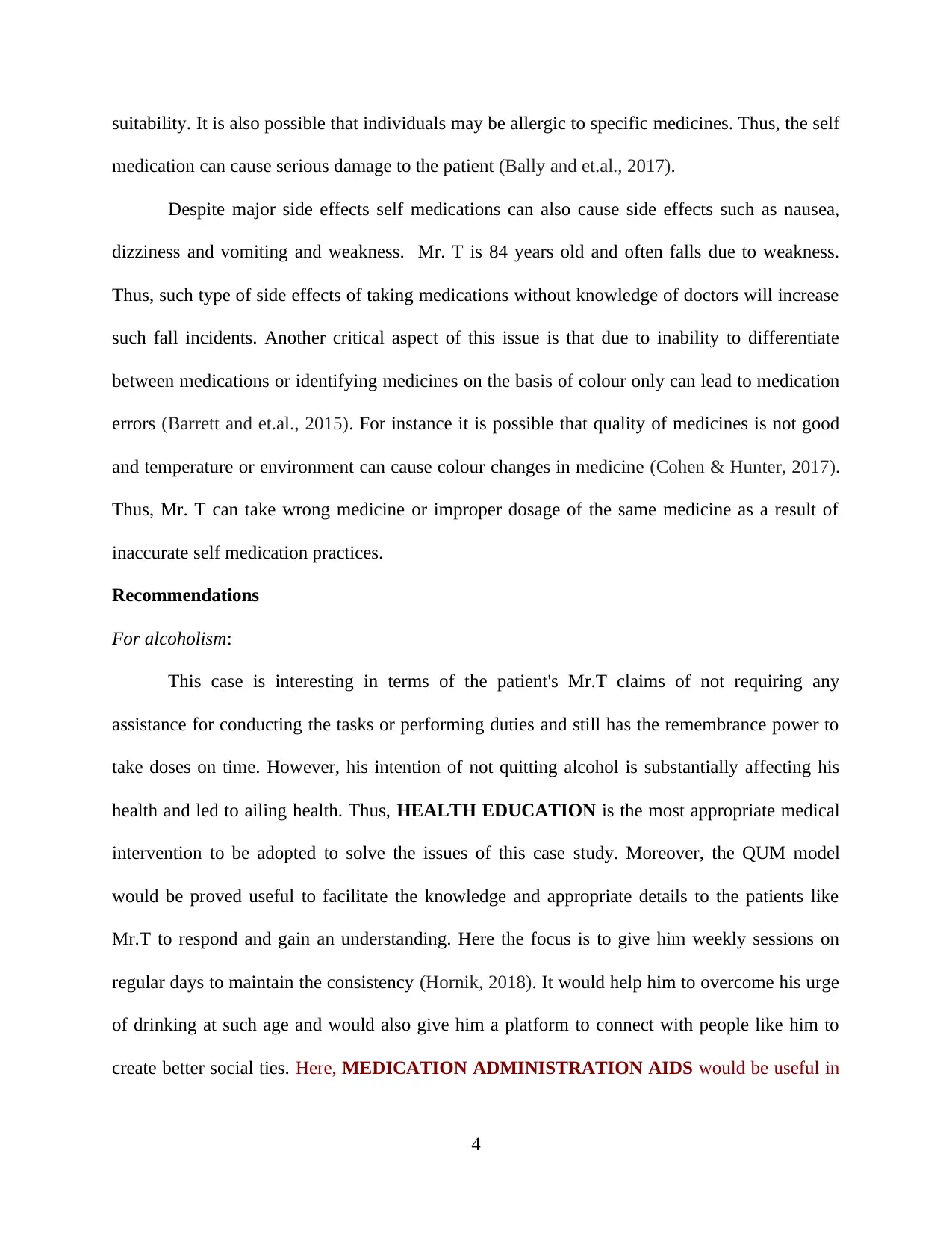
suitability. It is also possible that individuals may be allergic to specific medicines. Thus, the self
medication can cause serious damage to the patient (Bally and et.al., 2017).
Despite major side effects self medications can also cause side effects such as nausea,
dizziness and vomiting and weakness. Mr. T is 84 years old and often falls due to weakness.
Thus, such type of side effects of taking medications without knowledge of doctors will increase
such fall incidents. Another critical aspect of this issue is that due to inability to differentiate
between medications or identifying medicines on the basis of colour only can lead to medication
errors (Barrett and et.al., 2015). For instance it is possible that quality of medicines is not good
and temperature or environment can cause colour changes in medicine (Cohen & Hunter, 2017).
Thus, Mr. T can take wrong medicine or improper dosage of the same medicine as a result of
inaccurate self medication practices.
Recommendations
For alcoholism:
This case is interesting in terms of the patient's Mr.T claims of not requiring any
assistance for conducting the tasks or performing duties and still has the remembrance power to
take doses on time. However, his intention of not quitting alcohol is substantially affecting his
health and led to ailing health. Thus, HEALTH EDUCATION is the most appropriate medical
intervention to be adopted to solve the issues of this case study. Moreover, the QUM model
would be proved useful to facilitate the knowledge and appropriate details to the patients like
Mr.T to respond and gain an understanding. Here the focus is to give him weekly sessions on
regular days to maintain the consistency (Hornik, 2018). It would help him to overcome his urge
of drinking at such age and would also give him a platform to connect with people like him to
create better social ties. Here, MEDICATION ADMINISTRATION AIDS would be useful in
4
medication can cause serious damage to the patient (Bally and et.al., 2017).
Despite major side effects self medications can also cause side effects such as nausea,
dizziness and vomiting and weakness. Mr. T is 84 years old and often falls due to weakness.
Thus, such type of side effects of taking medications without knowledge of doctors will increase
such fall incidents. Another critical aspect of this issue is that due to inability to differentiate
between medications or identifying medicines on the basis of colour only can lead to medication
errors (Barrett and et.al., 2015). For instance it is possible that quality of medicines is not good
and temperature or environment can cause colour changes in medicine (Cohen & Hunter, 2017).
Thus, Mr. T can take wrong medicine or improper dosage of the same medicine as a result of
inaccurate self medication practices.
Recommendations
For alcoholism:
This case is interesting in terms of the patient's Mr.T claims of not requiring any
assistance for conducting the tasks or performing duties and still has the remembrance power to
take doses on time. However, his intention of not quitting alcohol is substantially affecting his
health and led to ailing health. Thus, HEALTH EDUCATION is the most appropriate medical
intervention to be adopted to solve the issues of this case study. Moreover, the QUM model
would be proved useful to facilitate the knowledge and appropriate details to the patients like
Mr.T to respond and gain an understanding. Here the focus is to give him weekly sessions on
regular days to maintain the consistency (Hornik, 2018). It would help him to overcome his urge
of drinking at such age and would also give him a platform to connect with people like him to
create better social ties. Here, MEDICATION ADMINISTRATION AIDS would be useful in
4
⊘ This is a preview!⊘
Do you want full access?
Subscribe today to unlock all pages.

Trusted by 1+ million students worldwide
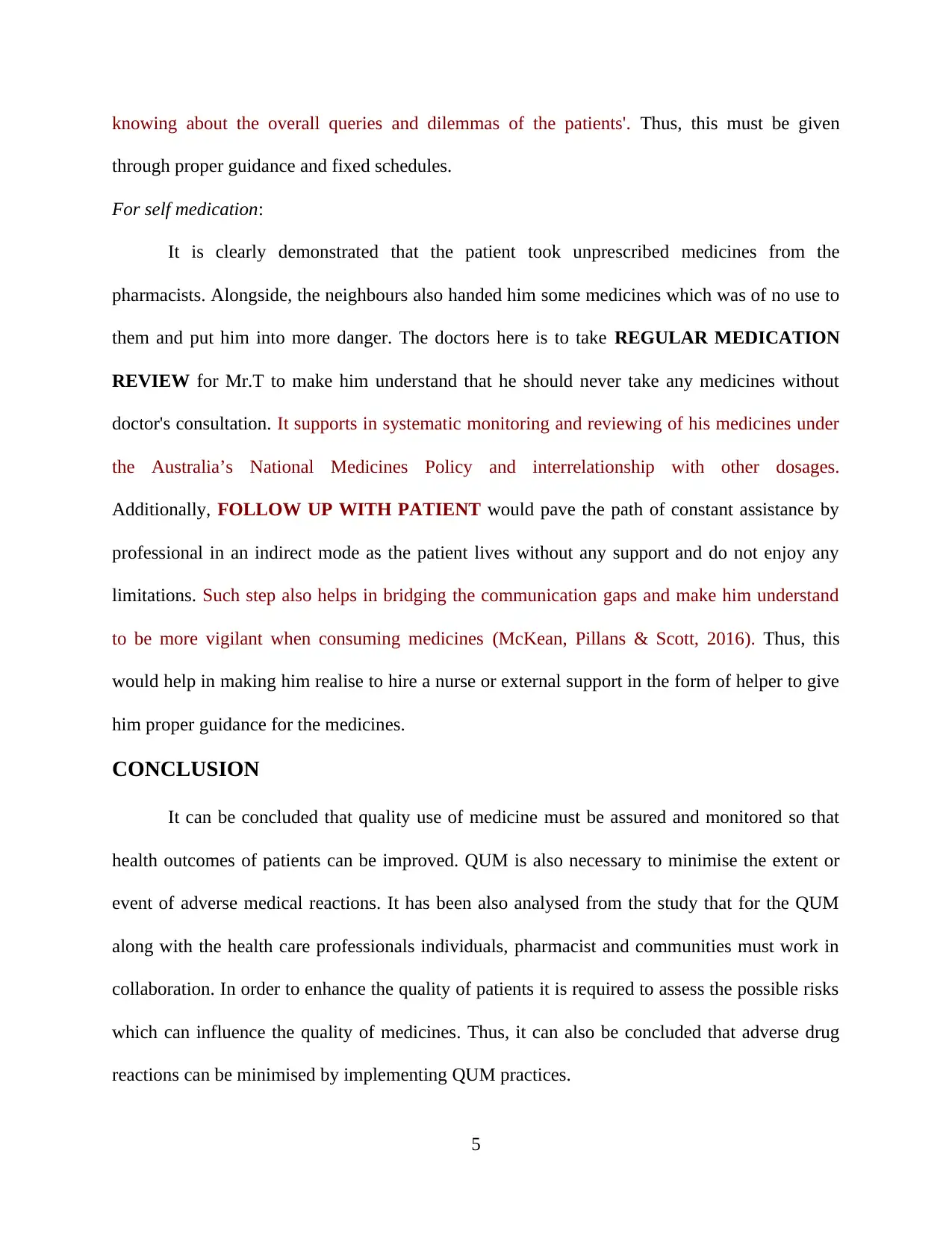
knowing about the overall queries and dilemmas of the patients'. Thus, this must be given
through proper guidance and fixed schedules.
For self medication:
It is clearly demonstrated that the patient took unprescribed medicines from the
pharmacists. Alongside, the neighbours also handed him some medicines which was of no use to
them and put him into more danger. The doctors here is to take REGULAR MEDICATION
REVIEW for Mr.T to make him understand that he should never take any medicines without
doctor's consultation. It supports in systematic monitoring and reviewing of his medicines under
the Australia’s National Medicines Policy and interrelationship with other dosages.
Additionally, FOLLOW UP WITH PATIENT would pave the path of constant assistance by
professional in an indirect mode as the patient lives without any support and do not enjoy any
limitations. Such step also helps in bridging the communication gaps and make him understand
to be more vigilant when consuming medicines (McKean, Pillans & Scott, 2016). Thus, this
would help in making him realise to hire a nurse or external support in the form of helper to give
him proper guidance for the medicines.
CONCLUSION
It can be concluded that quality use of medicine must be assured and monitored so that
health outcomes of patients can be improved. QUM is also necessary to minimise the extent or
event of adverse medical reactions. It has been also analysed from the study that for the QUM
along with the health care professionals individuals, pharmacist and communities must work in
collaboration. In order to enhance the quality of patients it is required to assess the possible risks
which can influence the quality of medicines. Thus, it can also be concluded that adverse drug
reactions can be minimised by implementing QUM practices.
5
through proper guidance and fixed schedules.
For self medication:
It is clearly demonstrated that the patient took unprescribed medicines from the
pharmacists. Alongside, the neighbours also handed him some medicines which was of no use to
them and put him into more danger. The doctors here is to take REGULAR MEDICATION
REVIEW for Mr.T to make him understand that he should never take any medicines without
doctor's consultation. It supports in systematic monitoring and reviewing of his medicines under
the Australia’s National Medicines Policy and interrelationship with other dosages.
Additionally, FOLLOW UP WITH PATIENT would pave the path of constant assistance by
professional in an indirect mode as the patient lives without any support and do not enjoy any
limitations. Such step also helps in bridging the communication gaps and make him understand
to be more vigilant when consuming medicines (McKean, Pillans & Scott, 2016). Thus, this
would help in making him realise to hire a nurse or external support in the form of helper to give
him proper guidance for the medicines.
CONCLUSION
It can be concluded that quality use of medicine must be assured and monitored so that
health outcomes of patients can be improved. QUM is also necessary to minimise the extent or
event of adverse medical reactions. It has been also analysed from the study that for the QUM
along with the health care professionals individuals, pharmacist and communities must work in
collaboration. In order to enhance the quality of patients it is required to assess the possible risks
which can influence the quality of medicines. Thus, it can also be concluded that adverse drug
reactions can be minimised by implementing QUM practices.
5
Paraphrase This Document
Need a fresh take? Get an instant paraphrase of this document with our AI Paraphraser
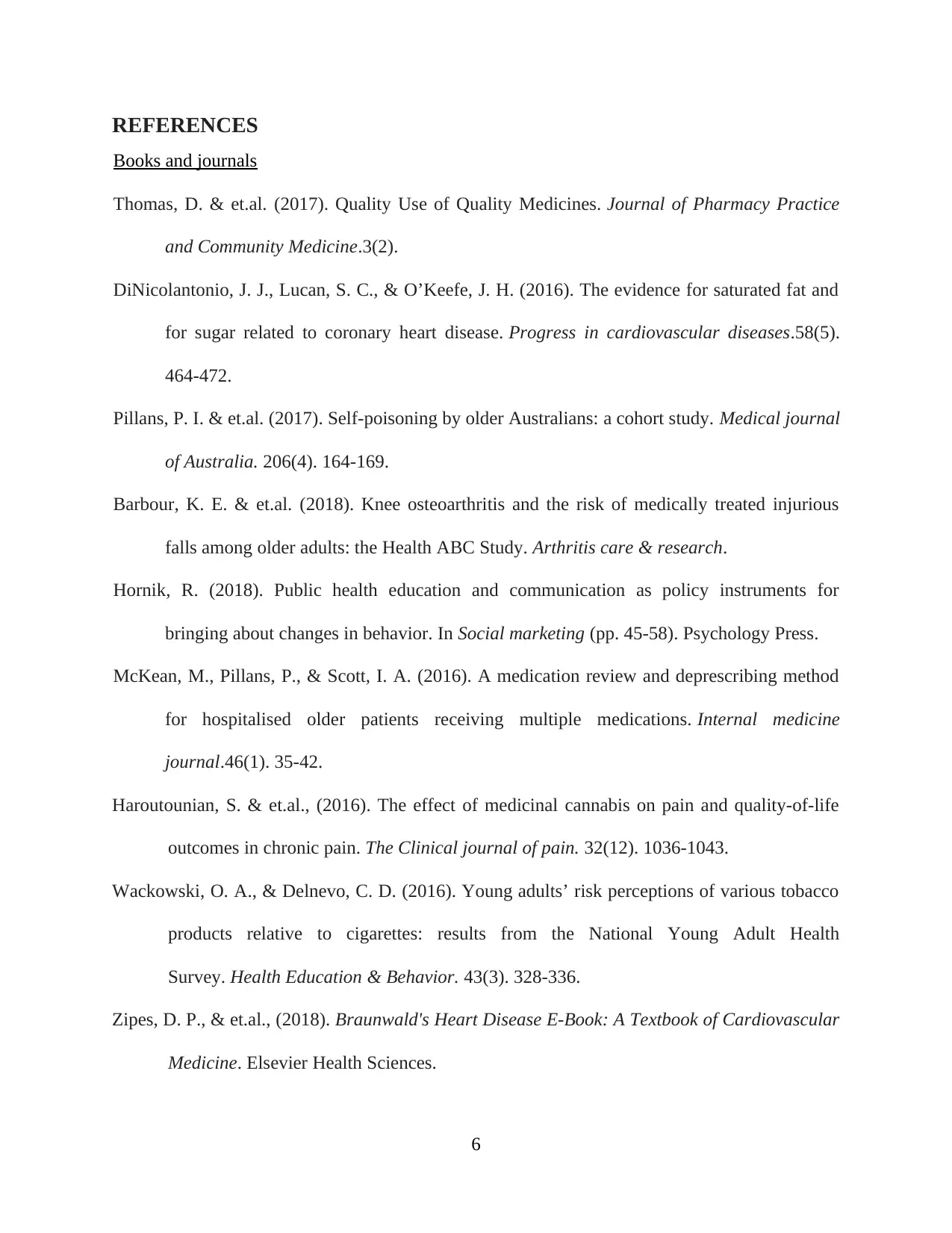
REFERENCES
Books and journals
Thomas, D. & et.al. (2017). Quality Use of Quality Medicines. Journal of Pharmacy Practice
and Community Medicine.3(2).
DiNicolantonio, J. J., Lucan, S. C., & O’Keefe, J. H. (2016). The evidence for saturated fat and
for sugar related to coronary heart disease. Progress in cardiovascular diseases.58(5).
464-472.
Pillans, P. I. & et.al. (2017). Self‐poisoning by older Australians: a cohort study. Medical journal
of Australia. 206(4). 164-169.
Barbour, K. E. & et.al. (2018). Knee osteoarthritis and the risk of medically treated injurious
falls among older adults: the Health ABC Study. Arthritis care & research.
Hornik, R. (2018). Public health education and communication as policy instruments for
bringing about changes in behavior. In Social marketing (pp. 45-58). Psychology Press.
McKean, M., Pillans, P., & Scott, I. A. (2016). A medication review and deprescribing method
for hospitalised older patients receiving multiple medications. Internal medicine
journal.46(1). 35-42.
Haroutounian, S. & et.al., (2016). The effect of medicinal cannabis on pain and quality-of-life
outcomes in chronic pain. The Clinical journal of pain. 32(12). 1036-1043.
Wackowski, O. A., & Delnevo, C. D. (2016). Young adults’ risk perceptions of various tobacco
products relative to cigarettes: results from the National Young Adult Health
Survey. Health Education & Behavior. 43(3). 328-336.
Zipes, D. P., & et.al., (2018). Braunwald's Heart Disease E-Book: A Textbook of Cardiovascular
Medicine. Elsevier Health Sciences.
6
Books and journals
Thomas, D. & et.al. (2017). Quality Use of Quality Medicines. Journal of Pharmacy Practice
and Community Medicine.3(2).
DiNicolantonio, J. J., Lucan, S. C., & O’Keefe, J. H. (2016). The evidence for saturated fat and
for sugar related to coronary heart disease. Progress in cardiovascular diseases.58(5).
464-472.
Pillans, P. I. & et.al. (2017). Self‐poisoning by older Australians: a cohort study. Medical journal
of Australia. 206(4). 164-169.
Barbour, K. E. & et.al. (2018). Knee osteoarthritis and the risk of medically treated injurious
falls among older adults: the Health ABC Study. Arthritis care & research.
Hornik, R. (2018). Public health education and communication as policy instruments for
bringing about changes in behavior. In Social marketing (pp. 45-58). Psychology Press.
McKean, M., Pillans, P., & Scott, I. A. (2016). A medication review and deprescribing method
for hospitalised older patients receiving multiple medications. Internal medicine
journal.46(1). 35-42.
Haroutounian, S. & et.al., (2016). The effect of medicinal cannabis on pain and quality-of-life
outcomes in chronic pain. The Clinical journal of pain. 32(12). 1036-1043.
Wackowski, O. A., & Delnevo, C. D. (2016). Young adults’ risk perceptions of various tobacco
products relative to cigarettes: results from the National Young Adult Health
Survey. Health Education & Behavior. 43(3). 328-336.
Zipes, D. P., & et.al., (2018). Braunwald's Heart Disease E-Book: A Textbook of Cardiovascular
Medicine. Elsevier Health Sciences.
6
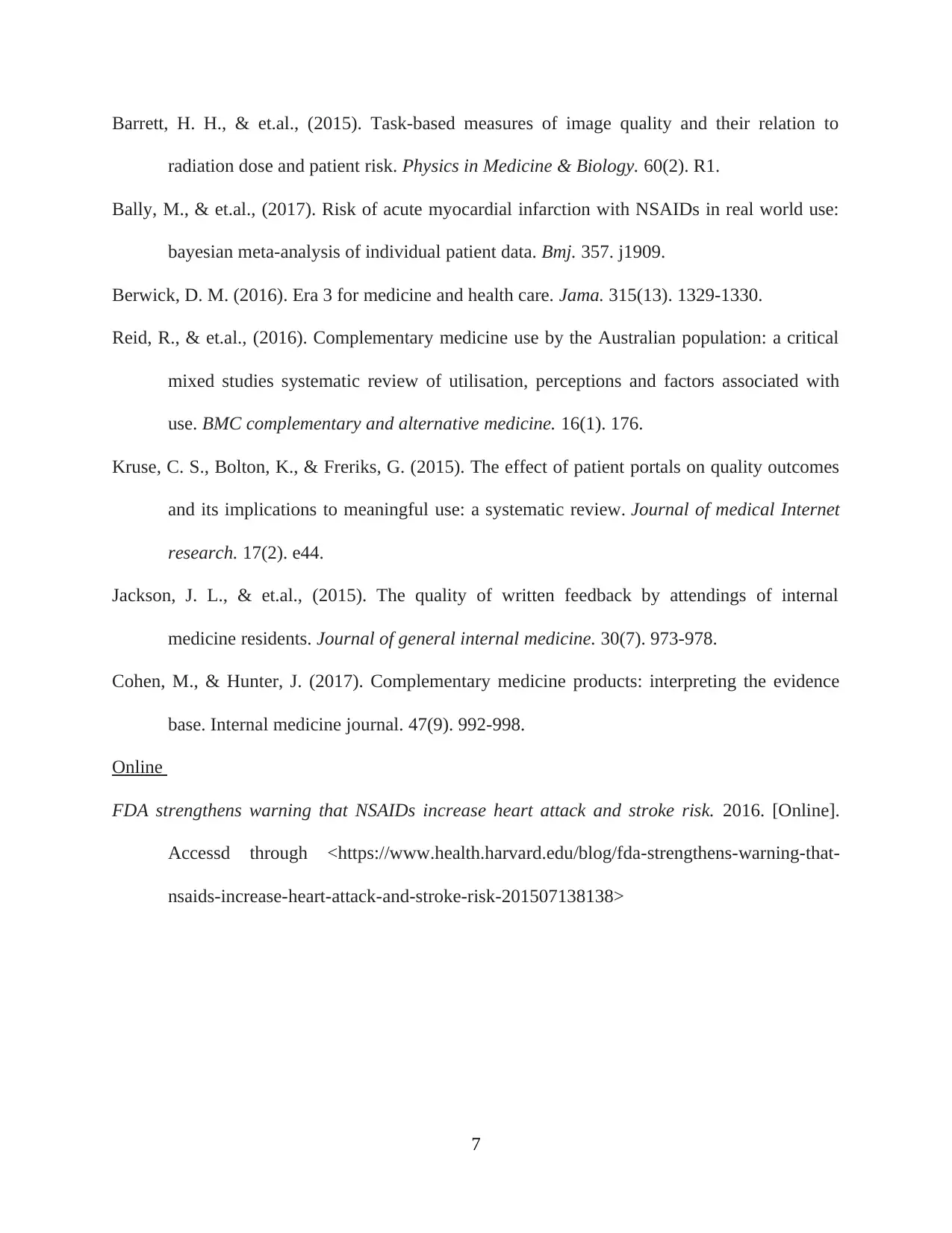
Barrett, H. H., & et.al., (2015). Task-based measures of image quality and their relation to
radiation dose and patient risk. Physics in Medicine & Biology. 60(2). R1.
Bally, M., & et.al., (2017). Risk of acute myocardial infarction with NSAIDs in real world use:
bayesian meta-analysis of individual patient data. Bmj. 357. j1909.
Berwick, D. M. (2016). Era 3 for medicine and health care. Jama. 315(13). 1329-1330.
Reid, R., & et.al., (2016). Complementary medicine use by the Australian population: a critical
mixed studies systematic review of utilisation, perceptions and factors associated with
use. BMC complementary and alternative medicine. 16(1). 176.
Kruse, C. S., Bolton, K., & Freriks, G. (2015). The effect of patient portals on quality outcomes
and its implications to meaningful use: a systematic review. Journal of medical Internet
research. 17(2). e44.
Jackson, J. L., & et.al., (2015). The quality of written feedback by attendings of internal
medicine residents. Journal of general internal medicine. 30(7). 973-978.
Cohen, M., & Hunter, J. (2017). Complementary medicine products: interpreting the evidence
base. Internal medicine journal. 47(9). 992-998.
Online
FDA strengthens warning that NSAIDs increase heart attack and stroke risk. 2016. [Online].
Accessd through <https://www.health.harvard.edu/blog/fda-strengthens-warning-that-
nsaids-increase-heart-attack-and-stroke-risk-201507138138>
7
radiation dose and patient risk. Physics in Medicine & Biology. 60(2). R1.
Bally, M., & et.al., (2017). Risk of acute myocardial infarction with NSAIDs in real world use:
bayesian meta-analysis of individual patient data. Bmj. 357. j1909.
Berwick, D. M. (2016). Era 3 for medicine and health care. Jama. 315(13). 1329-1330.
Reid, R., & et.al., (2016). Complementary medicine use by the Australian population: a critical
mixed studies systematic review of utilisation, perceptions and factors associated with
use. BMC complementary and alternative medicine. 16(1). 176.
Kruse, C. S., Bolton, K., & Freriks, G. (2015). The effect of patient portals on quality outcomes
and its implications to meaningful use: a systematic review. Journal of medical Internet
research. 17(2). e44.
Jackson, J. L., & et.al., (2015). The quality of written feedback by attendings of internal
medicine residents. Journal of general internal medicine. 30(7). 973-978.
Cohen, M., & Hunter, J. (2017). Complementary medicine products: interpreting the evidence
base. Internal medicine journal. 47(9). 992-998.
Online
FDA strengthens warning that NSAIDs increase heart attack and stroke risk. 2016. [Online].
Accessd through <https://www.health.harvard.edu/blog/fda-strengthens-warning-that-
nsaids-increase-heart-attack-and-stroke-risk-201507138138>
7
⊘ This is a preview!⊘
Do you want full access?
Subscribe today to unlock all pages.

Trusted by 1+ million students worldwide
1 out of 9
Related Documents
Your All-in-One AI-Powered Toolkit for Academic Success.
+13062052269
info@desklib.com
Available 24*7 on WhatsApp / Email
![[object Object]](/_next/static/media/star-bottom.7253800d.svg)
Unlock your academic potential
Copyright © 2020–2025 A2Z Services. All Rights Reserved. Developed and managed by ZUCOL.





